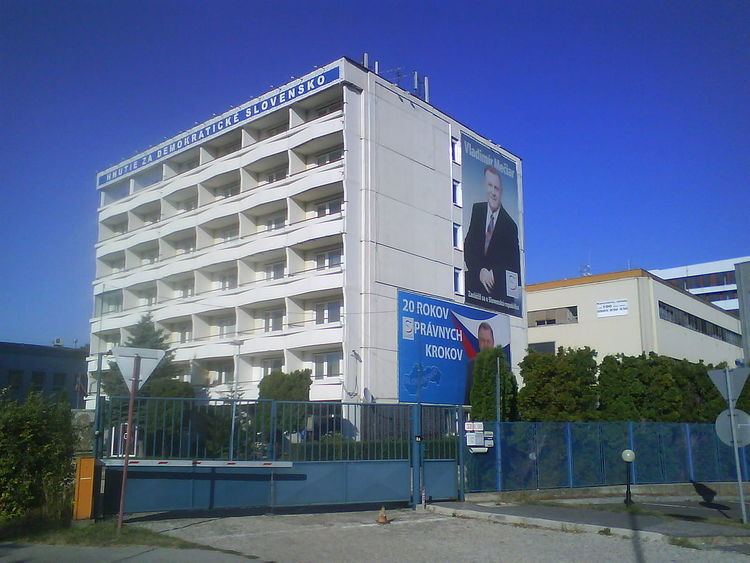Dissolved 11 January 2014 Political position Right-wing | Founded 27 April 1991 | |
 | ||
Ideology National conservatism,Right-wing populism | ||
The People's Party – Movement for a Democratic Slovakia (Slovak: Ľudová strana – Hnutie za demokratické Slovensko, ĽS-HZDS) was a national conservative political party in Slovakia. The party was dissolved after it failed to secure any seats in the National Council in the 2012 elections, having lost them in the 2010 election. The party was in the government from 1992 to 1998 (with a short break in 1994), and was the largest party from 1991 to 2006.
Contents
Founded in 1991, its leader is Vladimír Mečiar, who, as Prime Minister, led Slovakia through the Velvet Divorce. The party has been a member of the Slovak government three times: twice as the leading partner with Mečiar as Prime Minister (1992–4, 1994–8) and from 2006 - 2010 as the junior partner under Robert Fico of Direction – Social Democracy.
Founded in opposition to privatisation, the party's ideology has shifted repeatedly, with the only constants being Mečiar's leadership and a populism that alienated it from other parties in Slovakia and abroad. To overcome its previous reputation as a 'pariah', the party has touted its support of European integration. It was a member of the integrationist European Democratic Party, despite not sharing the liberal ideology of that organisation.
Velvet Revolution
The party was created as a Slovak nationalist faction of Public Against Violence (VPN), from which it seceded at an extraordinary VPN congress on 27 April 1991. Called 'Movement for a Democratic Slovakia' (HZDS), it was led by Vladimír Mečiar, who had been deposed as Slovak Prime Minister a month earlier, and composed mostly of the VPN's cabinet members. The HZDS claimed to represent Slovak national interest, and demanded a more decentralised Czechoslovak confederation. On 7 May 1992, the HZDS voted for a declaration of independence, but this was defeated 73-57.
At the first election in which it took part, on 5–6 June, the HZDS won an overwhelming victory, with 74 seats on the National Council: two short of an absolute majority. Mečiar was appointed Prime Minister on 24 June. Whereas the HZDS wanted a confederation, the Czech elections on the same day were won by Civic Democratic Party, which preferred a tighter federation. Recognising that these positions were irreconcilable, the National Council voted for Slovakia's Declaration of Independence by 113 votes to 24, and Mečiar concluded formal negotiations over the dissolution of Czechoslovakia.
Dominant party
The party adopted a populist left-wing position economically, and sought to slow the post-Soviet privatisation and liberalisation.
In the first elections after independence, in late 1994, the HZDS retained its dominant position, winning 58 seats (the Peasant's Party of Slovakia won a further 3 on its list).
Decline in opposition
Originally designating itself as a centre-left party, the party moved towards the mainstream right and, in March 2000, renamed itself the 'People's Party – Movement for a Democratic Slovakia' (ĽS-HZDS) to try to achieve membership of the European People's Party (EPP). However, lingering memories of former anti-Europeanism, conflicting rhetoric, and the presence of three Slovak parties already in the EPP prevented this. The ĽS-HZDS then looked to the Euro-integrationist European Democratic Party, which it joined in 2009.
The build-up to the 2002 election saw Mečiar exclude a number of prominent members from the party's list of candidates. Several of the excluded members, led by Ivan Gašparovič, split from the party and founded the similarly titled Movement for Democracy (HZD). The new party won 3.3% of the vote, eating significantly into the ĽS-HZDS's position, and contributing to it winning only 36 seats. By 2006, further divisions and splits had reduced it to only 21 MPs.
Back in government
In the parliamentary election of 17 June 2006, the party won 8.8% of the popular vote and 15 out of 150 seats.
Two ĽS-HZDS ministers were sworn in with the Robert Fico government on July 4, 2006:
In the 2010 election the party lost all its seats, after its share of the vote halved to below the 5% threshold for entering parliament.
